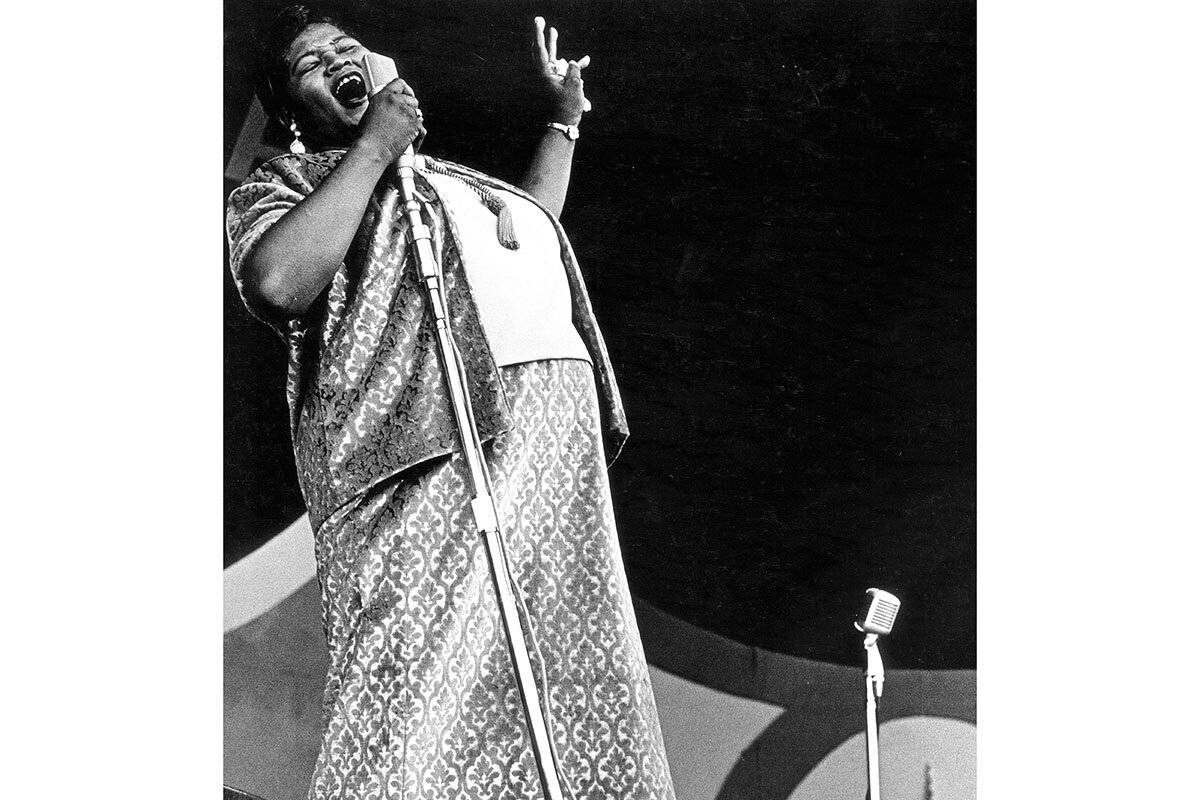Women created the blues. Now they are taking it back.
Loading...
When blues legend Buddy Guy headlined one of Asia’s signature musical events of 2020, he invited several other artists on the bill to jam with him onstage for an encore – including two women from Nashville, Tennessee.
For Rebecca and Megan Lovell, who record under the moniker Larkin Poe, appearing at the Mahindra Blues Festival in India was a highlight of a year that also included earning a Grammy nomination for best contemporary blues album.
The millennial guitarists have been building their reputations since they were teenagers. (Fun fact: They named their group Larkin Poe after their great-great-great-grandfather, a cousin of Edgar Allan Poe.) They’ve appeared on a solo album by Aerosmith’s Steven Tyler. They opened for Keith Urban’s tour in 2019. And the sisters blew back Conan O’Brien’s pompadour when they performed on his talk show.
Why We Wrote This
Many blues pioneers were Black women. But later, with the rise of the electric guitar, the genre was taken over by men. Now young female artists are grabbing Gibsons and reinvigorating the art form.
At the Indian blues festival in February, Larkin Poe was hailed as the breakout act as the sisters played tectonic riffs that probably registered on the Richter scale.
“While Megan raised eyebrows with her ability to shred as skilfully as the more famous axe wielders on the bill, Rebecca showcased a powerful voice,” wrote a reviewer at Indian news site Firstpost.
Their appearance offered a snapshot of how the blues is evolving. The music that originated in the late 1800s from Black workers in the American South is becoming increasingly international, multigenerational, and – most strikingly – female.
When the first gramophone recordings of the blues emerged a century ago, its primary recording artists were Black female singers. But once the genre started to center around the electric guitar, it became largely dominated by men. That’s now changing. Young female artists such as Samantha Fish, Joanne Shaw Taylor, Jackie Venson, and the sister-led Larkin Poe are emerging as the genre’s new leading lights. To stake out their place, these Generation Z and millennial women have had to uproot a deeply embedded cultural notion: Girls can’t play the electric guitar as well as boys.
These contemporary female artists are helping to strip the blues of its “OK, boomer” tag by offering fresh musical perspectives. They are bringing new songs, new lyrics, and greater diversity to a genre that is one of America’s original art forms – and a source of cultural expression around the world. Perhaps most important, by gaining admission to one of the oldest boys clubs in music, they’re empowering a new generation of young women to start playing music.
“What’s happening is this resurgence of the females of the blues,” says Sarah Rogo, an up-and-coming, 20-something blues guitarist in Los Angeles whose fans include ZZ Top’s Billy Gibbons. “A lot of it has to do with the guitar and the resurgence of females in the guitar. It’s like a chain effect.”
“Blue” notes
A century ago, things looked markedly different for women in the blues. The nascent music came out of juke joints in the South frequented by cotton-field workers. It was confined to African American venues on what was known as the Chitlin’ Circuit.
The most popular blues performers in places like Beale Street in Memphis, Tennessee, and Tuxedo Junction in Birmingham, Alabama, were Black women. Notably, these singers bent their voices to sing something unheard-of in staid European music capitals: minor “blue” notes in between major notes over 12-bar shuffles. The blues drew on the call-and-response of spirituals. It was a sorrowful sound.
Yet the women who helped pioneer the genre were shut out from the recording industry. Then, in 1920, vaudeville singer Mamie Smith convinced the Okeh label there would be a huge Black audience for her recordings. Her second release, which included the song “Crazy Blues,” made her the Adele of her era.
“It’s the first song to bring in a million dollars, and it really set a precedent for women taking the stage and starting to become recording artists,” says Lynn Orman Weiss, head of the Women of the Blues Foundation. “Bessie Smith, Alberta Hunter, and Mamie Smith were huge stars.”
In the 1930s, the blues quickly evolved. The jazzy ragtime style was overtaken by folkier, acoustic guitar variants such as country blues and Delta blues, ushering in the likes of Robert Johnson. When the big migration of Southern workers to the urban Midwest coincided with the arrival of the electric guitar, it gave birth to the Chicago blues style that predominates to this day.
Ironically, many white Americans and Europeans – the largest audiences for modern blues – were introduced to some of the Black legends of the genre only through British blues guitarists such as Eric Clapton, Jimmy Page, and Keith Richards.
Since then, the blues has been dominated by lead guitar players – and men. Relatively few women have been prominent stars since the 1950s.
Until now.
Last year, for instance, guitar slinger Samantha Fish of Kansas City, Missouri, achieved something that the current biggest artist in blues – Generation X virtuoso Joe Bonamassa – has never been able to. She was reviewed in The New York Times. And the guitarist and singer’s sixth solo album, “Kill or Be Kind,” wasn’t just lauded by the Times. Variety hailed its single “Bulletproof” as “probably the best new rock song we’ve heard all year, and maybe for a few years.”
She and other millennials – including Danielle Nicole and Chantel McGregor – are following a path blazed by several Gen Xers. Chief among them is Susan Tedeschi, who shares guitar duties with husband Derek Trucks in the immensely popular, Grammy-winning Tedeschi Trucks Band. Ana Popović, originally from Serbia, is a regular fixture of the Billboard blues charts and has been praised by USA Today and NPR. And Carolyn Wonderland (not her birth certificate name, in case you’re wondering) is now the lead guitarist for John Mayall, the legendary British blues artist.
“There is such a refreshing breath of feminine energy intertwining with the blues yet again ... bringing it back to the masses,” says Rebecca Lovell of Larkin Poe.
“Blues music is born from some pain and suffering and really deeply human experiences of oppression,” she notes. “And yet it’s been transfigured into this expression of joy.”
You won’t get an argument about joy from Ms. Taylor, the millennial blues star. In 2012, when Annie Lennox performed at the Queen’s Diamond Jubilee Concert on a stage outside Buckingham Palace, 17 million television viewers were treated to an uncommon sight.
It wasn’t the angel wings that she and her band donned for a bluesy rendition of the Eurythmics hit “There Must Be an Angel.” Nor was it Ms. Lennox’s rock ’n’ roll move of repeatedly twirling her microphone cord over her head as if it were a helicopter rotor. It was the sight of Ms. Taylor stepping forward to play a wailing guitar solo.
“It was shortly before my mom passed away,” says Ms. Taylor, who is from the West Midlands region of England and cracked the top 20 album chart in the United Kingdom with her 2019 album, “Reckless Blues.” “I’m very thankful that she got to see something big that she talked about forever.”
Ever since the invention of the electric guitar, there have been women such as Ms. Taylor who have excelled at playing the instrument. Yet in popular culture, they have largely been an invisible minority. During the height of the guitar hero era between the 1970s and 1990s, even the most gifted female players were seldom featured on MTV or radio. Other highly accomplished guitarists such as Joni Mitchell were frequently underrated because they weren’t as flashy or mostly played acoustic guitar.
As a result, the guitar came to be widely viewed as a masculine instrument. Hence the use of terms such as “ax man.”
“As a young teenager, I felt kind of out of place when I even contemplated learning how to play lead guitar,” says Ms. Fish, whose snarling slide solo on “Bulletproof” could blow the cobwebs off a pair of stereo speakers. “I felt there was a little bit of even just a psychological thing with me where I wasn’t sure if that was something that women do.”
Novices on the instrument may have been intimidated by the idea of entering guitar stores that were heavily staffed by men. Indeed, until recently, the industry hasn’t been welcoming to women. For decades, bikini-clad models posing with fretboards were a regular sight in guitar magazines and trade-show booths. The sexist message to men: Want to attract women? Play guitar.
Yet artists like Ms. Fish and Ms. Taylor weren’t deterred from plugging in amplifiers. They’re of a generation whose mothers had careers. Younger women have also been taught to smash glass ceilings, as well as perhaps the occasional guitar.
“It’s not just the mom saying it; it’s the dads saying it as well,” says Christine Hassler, author of the “20 Something Manifesto” and an expert on millennials. “And so they don’t really see the gender barrier as much.”
Years before she became a British blues star, Ms. Taylor recalls that she and her father would watch VHS tapes of guitar greats. Other than Bonnie Raitt, there weren’t many female role models for her to look up to. Instead, the self-taught guitarist worked hard to emulate the likes of Stevie Ray Vaughan.
“We see ourselves reflected in the artists we look up to, don’t we? I apparently saw myself reflected in a cowboy from Austin, Texas, for some reason,” she laughs.
The increasing prominence of female artists in the blues mirrors what’s happening elsewhere in the music industry. In 2020, many of the biggest artists in popular music are millennial and Gen Z women. One has to take a very deep breath before listing just some of the household names who are topping the charts, winning Grammys, and garnering critical acclaim: Billie Eilish, Dua Lipa, Cardi B, Taylor Swift, Beyoncé, Kacey Musgraves, Lana Del Rey, Ariana Grande, and the Korean group Blackpink.
For all the high-profile success of many of these artists in dominating popular culture, the totality of the music industry is still dominated by men. Heavily so. A 2020 study by the Annenberg Inclusion Initiative at the University of Southern California examined 800 popular songs and found that just 21% of them were by female artists. Just 12.5% of those songs were written by women. Very few producers are women. Many female artists aren’t taken as seriously as men.
But displays of virtuosity on guitar are helping to change perceptions. Just look at what happened when Shakira picked up her Gibson Firebird and scorched the Super Bowl halftime show.
“As far as women in pop music, they were more traditionally featured without instruments and they were more thought of as pure vocalists. But the barriers have broken down quite a bit in recent years,” says Alexx Calise, a journalist for Guitar Girl Magazine and a successful modern-rock artist. “There are a lot more female guitarists to look to now.”
In mainstream music, however, the guitar is often not so much a lead instrument as a textural one. Last year, Rolling Stone magazine even posed the question, “Is the guitar solo finished?”
For young women who wish to stretch out on the fretboard, the blues still represents a haven. It’s a genre of music in which young women can fully explore the instrument’s expressive qualities by letting it rip.
Rebirth
Jackie Venson has never forgotten her first big breakup. In 2011, during her senior year at the Berklee College of Music in Boston, she fell out of love with music. A classically trained pianist since childhood, she found herself uninspired and barely playing at all.
But while hanging out with some college friends, the young Texan discovered her passion again. Watching a fellow student play guitar, she was struck by how much fun he was having. Ms. Venson got a guitar and started teaching herself the blues. In the instrument, she found her voice.
“I wish I was a better singer,” she says. “It’s not something I’ve ever really been able to achieve with the tools I’ve been given. But I can achieve it on the guitar ... in the tone and in the speed and the bending. I can achieve the same excitement that gospel singers achieve when they sing.”
Ms. Venson is now an ascending star of the blues. In early October, she taped an episode of “Austin City Limits” for PBS.
This year, almost a decade after Ms. Venson graduated from Berklee, the college’s guitar department registered its highest number of women in the incoming class. “They’re very high-level players,” says Sheryl Bailey, assistant chair of the department, whose female students number between 10% and 15%. By contrast, when Ms. Bailey attended Berklee as a student in the mid-1980s, she was one of just two women in the program of about 1,000 students.
The trend goes beyond music schools. Two years ago, the Fender guitar company released a study showing that 50% of new guitar players are female.
“Do we see the trend that there are more females playing or within the music industry at large than ever? Yes, absolutely,” says Elizabeth Heidt, global head of entertainment relations at Gibson Brands, the manufacturer most famous for making guitars such as Les Pauls. But she adds that the trend has been building for quite a while, abetted by technology. Social media has helped encourage more diversity in the industry. “We’re out there playing and we can find someone else that looks and sounds like us,” says Ms. Heidt. “So we can feel comfortable and connect.”
Many budding guitarists are learning how to play by tapping into the thousands of instructional videos on YouTube. Typical of their generation, Gen Zers also post videos of how they’ve mastered tricky hopscotches on the fretboard.
“I always joked that, you know, the next generation better be far better guitar players than me because I literally had to cycle into my local town and ask for a B.B. King CD that would be delivered to me in six weeks at my local record shop,” says Ms. Taylor. “And now, you know, they’ve got every tutorial available to them on YouTube. So they’d better be better and up the game!”
“She’s a Self Made Man”
The new generation of blues artists is certainly changing the genre. They’re bringing a broader range of subject matter to an ancient form of music, making it more relevant to the 21st century.
When it comes to lyrics, for instance, they’re avoiding lazily regurgitated clichés.
That means no songs about how my baby just left me on a southbound train, leaving me here at the crossroads because someone stole my truck. And my dog just died. Instead, younger artists are penning songs that deal with topics such as social justice, domestic issues, equality, and, of course, love, observes Ms. Orman from the Women of the Blues Foundation.
Larkin Poe likes to get playful with words. The lead single from its most recent album is titled “She’s a Self Made Man.”
“My sister and I, we have said the phrase ‘self-made man’ time and time again our entire lives and used it as an expression of respect without ever having really cottoned on to the fact that you are qualifying success by gender,” explains lap-steel guitarist Megan Lovell.
The duo isn’t averse to changing up the blues in other ways. Like many young artists, they draw from a wide range of musical genres. Their upcoming covers album, “Kindred Spirits,” includes rootsy renditions of songs ranging from those by The Moody Blues to Phil Collins to hip-hop star Post Malone.
Similarly, Ms. Fish isn’t afraid to upset some purists by moving from acoustic country blues to synthesizer textures.
“Blues fans are definitely a specific demographic,” says Ms. Fish. “All you have to do is look around at a festival and you’re going to see a lot of the 40- to 60-year-old men in the crowd. I don’t think my gender is really so much going to change that. But ... I’m constantly reaching and trying new things with my music.”
Ms. Venson has cultivated a multigenerational audience by using platforms such as TikTok and Twitter to get her hip-hop-influenced blues music heard. (Who needs radio anymore?) During one three-month period of the pandemic lockdown, her nearly daily live performances on Facebook drew a cumulative audience of 1.5 million, according to the concert industry publication Pollstar. Despite being a relative latecomer to the guitar, she’s put in the requisite practice to overcome sexist skepticism that she wouldn’t be able to cut it.
“I knew I was going to come up against that,” she says. “If I am just genuinely really good, then it doesn’t matter that it’s there because it doesn’t apply to me.”
A common refrain among these artists is their hope that the qualifier “female” guitar player will someday vanish from the popular lexicon.
“If someone just played some music, does that matter to you, the gender?” asks Ms. Bailey, the jazz guitar maestro who co-chairs Berklee’s guitar department. “Do they have to set it up? ‘Listen to this male guitarist or white guitarist or Asian guitarist.’ No, just, ‘Listen to this guitarist.’”
At the Indian blues festival earlier this year, the final gathering of performers represented a genre of music that is less and less defined by labels. The players were male, female, young, old, American, and Indian. For Larkin Poe, it was a moment of just being present in the music.
“We definitely feel that it is an underrated genre. It is not prized in the way that it should be,” says Rebecca Lovell. “Just to be a part of the fresh blood who are coming in and attempting to shine light upon these legends of music that certainly don’t get the attention and respect that they deserve ... that is gratifying.”











